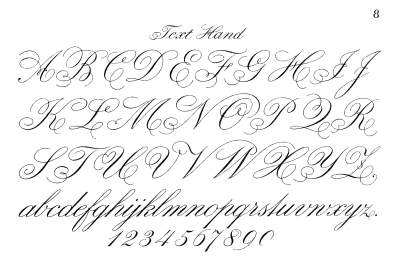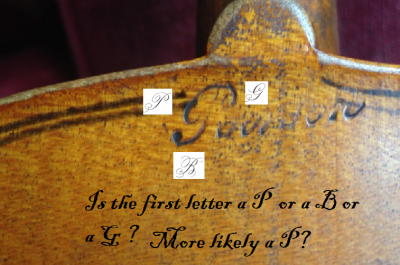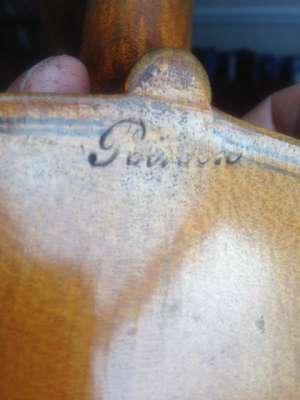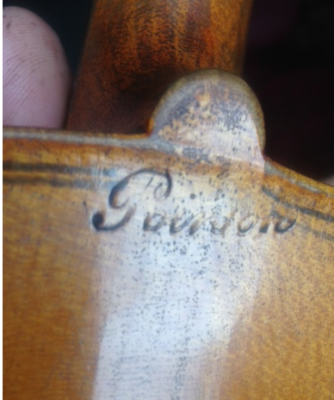Welcome to our forum. A Message To Our New and Prospective Members . Check out our Forum Rules. Lets keep this forum an enjoyable place to visit.
Currently working on errors from the latest (SimplePress) forum update. Many issues have been resoled and others are being worked on. Thank you for your patience.
 Topic RSS
Topic RSS



 (13 votes)
(13 votes) Regulars
 Offline
Offline







Just trying to help mate, you said you wanted to know what your violin is so I told you were you to ask, I also told you they had an attitude problem but unless you want to pay for an expert like saunders to look at your fiddle your only option is maestronet, if you dont want to use them up to you.
Cant beat a sunny day
Regulars
 Offline
Offline








@MikeSutton -
My Father used extremely ornate cursive, but back to the point - this might be of help.
Your photo doesn't show fancy cursive & there are a zillion script fonts, but this caught my eye.
Looks like P? But, you really had me thinking twice about the "B"! (lol)
I enlarged your photo to 400%.
I was wondering if I'm seeing some colorless indent in the wood, remnants of the branding, parts of letters you might be able to highlight with some powdered graphite/charcoal/chalk, etc... something easily removed again?
Member
ELCBK said
@MikeSutton -My Father used extremely ornate cursive, but back to the point - this might be of help.
Your photo doesn't show fancy cursive & there are a zillion script fonts, but this caught my eye.
Looks like P? But, you really had me thinking twice about the "B"! (lol)
I enlarged your photo to 400%.
I was wondering if I'm seeing some colorless indent in the wood, remnants of the branding, parts of letters you might be able to highlight with some powdered graphite/charcoal/chalk, etc... something easily removed again?
Yes I was wondering about using something like fingerprint powder too. I expect it will do no harm. There are indentations around the remnants of the engraved letters in the brand name that might be letters. I think its worth giving it a go. I will try to get hold of some and see.
Regulars
 Offline
Offline





@MikeSutton
In one of your other posts you say that it used to say "Breton"; and it seems that there's a perception that it might be faint because it has worn away.
But I think the truth is that it has been branded on with more pressure on the lower edge than on the upper edge, and it has always looked the way it looks now, barring the grime in the pores. If it were a B, the lower area is precisely where we'd see evidence of that. So it's probably a P, although in this picture it could be a G and the word looks somewhat clearer, so perhaps more photos are required with different lighting?
Also the word Breton tends to be underlined with a flourish. Mine has the same flourish, but it is a lot fainter.
I think the last three letters are "son". But what comes in between is a mystery. Something like Pourson. Poulson?
But the problem with Corilon is that you have a vast list of names, some of whom may only have produced master violins and some of whom may only have produced amateur instruments, and choosing one that looks right is not the be-all-and-end-all - you have also to match a name to a certain violin. And for that you need Maestronet to tell you which is which.
Andrew
Verified human - the ignominy!
Member
The Bretton/Breton possibility was not raised by me. However, I was certainly prepared to consider it as being correct - especially in light of the hand writing inside that I first read when I opened it as possibly being Bretton or Breton before that possibly was raised in this forum of that being the brand name on the back as well. And that handwriting inside does definitely read 1836. I have no idea who the writer "Thomas Stone" could be other than someone who likely repaired the violin in on 10th December 1836 - or else perhaps made it in a workshop for someone else in charge on that day.
Considering it again, especially with your help and that of Emily I think the first letter is more likely a P too.
I added a little fingerprint powder to the brand. See new image. Now, to me it reads Poirson. Possibly, but perhaps less probably, Pourson?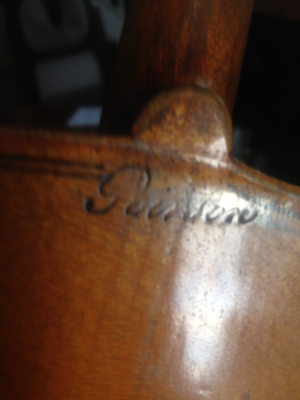

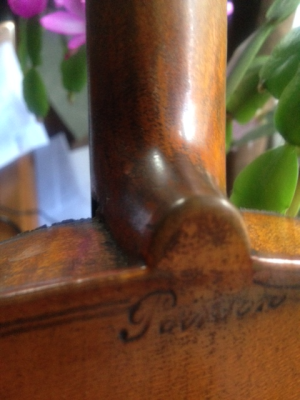
 .
.
Regulars
 Offline
Offline





Poinson looks like the best choice in the first photo, but the name is not in Corilon. (Poisson is possible, but the "ss" isn't convincing - perhaps that indeed makes Pourson more likely)
Yes, I "raised the possibility that it says Breton" (during three hours of scrabbling around for evidence), but I was shocked by your triple response: -
"the fact it says Breton inside in pencil" - it doesn't, and I had said it didn't.
"So, thanks to the help form Gordon. It says Breton." No, I suggested it said Bretton (sic).
"thanks to the very kind help from Gordon Shumway, it says (once said) Breton." No again.
I responded rudely. I apologise for that.
But if your are a doctor (concessive "if"), I must point out that the word "methodology" is important here.
Looking at all the possibilities and cross-referring them with Corilon, my final guess would be that it's by one of the Poirson dynasty.
So my approach now would be to go to maestronet and start a thread entitled "The Poirson Dynasty" (assuming there's not already something there about them). That might attract people's attention. Then tell them you assume the violin is by one of them, post the pictures and see what responses you get.
Curiously, there are a fair few Poirsons in French Wiki, but none is a luthier.
https://fr.wikipedia.org/wiki/Poirson
A brief foray into maestronet has told me that perhaps more Poirsons were archetiers than luthiers, and French luthiers such as the Poirsons often provided white violins for the Turin school.
https://maestronet.com/forum/i.....ent-886277
https://maestronet.com/forum/i.....ent-650457
If Poirson's factory/workshop made some nice violins, that doesn't mean that every violin they made was nice. In the same way, if Raleigh made bikes for £100, £500 and £1,000, you wouldn't assume the £100 bike was as good as the £1,000 one.
Andrew
Verified human - the ignominy!
Member
Gordon, my methodology is to get to the bottom of the mystery by keeping an open mind and responding on a forum. Obviously, this is not an academic research study. I am open to embracing the thinking of those who might see things differently to me. That is the opposite of "confirmation bias". I am just informally evidence gathering to weigh that evidence with the help of others far more experienced than I am. That is why I asked strangers (to me) for their help. Namely, people like you who gave up their time to look deeper into this little question and to think about it. Thank you for doing so.
I apologise for enthusiastically embracing what someone more expert than me (I'm no expert on this topic) wrote and for misunderstanding what they wrote in light of my inexperience. But the accusation of confirmation bias in all of that is unfair. I'm not here to confirm anything. I am here to be advised by those more expert than myself. I I know that at least for sure.
Regulars
 Offline
Offline





Member
Gordon Shumway said
Poinson looks like the best choice in the first photo, but the name is not in Corilon. (Poisson is possible, but the "ss" isn't convincing - perhaps that indeed makes Pourson more likely)Yes, I "raised the possibility that it says Breton" (during three hours of scrabbling around for evidence), but I was shocked by your triple response: -
"the fact it says Breton inside in pencil" - it doesn't, and I had said it didn't.
"So, thanks to the help form Gordon. It says Breton." No, I suggested it said Bretton (sic).
"thanks to the very kind help from Gordon Shumway, it says (once said) Breton." No again.
I responded rudely. I apologise for that.
But if your are a doctor (concessive "if"), I must point out that the word "methodology" is important here.
Looking at all the possibilities and cross-referring them with Corilon, my final guess would be that it's by one of the Poirson dynasty.
So my approach now would be to go to maestronet and start a thread entitled "The Poirson Dynasty" (assuming there's not already something there about them). That might attract people's attention. Then tell them you assume the violin is by one of them, post the pictures and see what responses you get.
Curiously, there are a fair few Poirsons in French Wiki, but none is a luthier.
https://fr.wikipedia.org/wiki/Poirson
Sorry, but I have no intention of asking anyone on Maestronet for advice. My past experience there (and what others messaged me at the time of their own dreadful experience) is that is a weird site where violin dealers and one particular queen bee Luthier/repairer weirdly pile-on to accuse those who ask questions of having some hidden agenda to use what they say to sell violins on eBay. Even though those so accused have never done any such thing and have no intention of ever doing so. And the moderators do nothing about it. Dreadful place in my opinion.
Regulars
 Offline
Offline





My Raleigh analogy was perhaps not a great one, but it works if you remember that all Raleighs have a label saying "The Raleigh".
If we go back to freshers' level source analysis and begin with the objective and delay the subjective, what you have is a violin with painted purfling, sorry to harp on about it. Yes, it may end up sounding nicer than a Stentor, but if you resell it, you mustn't oversell it. (I typed this before seeing your complaint about maestronet)
Something purely subjective, which hasn't been mentioned before, is that the pegs look nice and I'd guess that they weren't original. Are they boxwood?
Andrew
Verified human - the ignominy!
Regulars
 Offline
Offline





Member
If I do re-sell it at some point in the future I will do so only to a student of any of the violin teachers I know and I will do for a price so low they could (if they wished) immediately re-sell it for more than they paid. I know its no master-piece for sure. But I am close to certain (but happy to be proven wrong) I can make it sound nicer to the ears of a music teacher than any modern Stentor on the market. But I don't currently have any intention of selling it. I may do so only if someone like one of my local violin teachers plays it and soon after quite rightly shames me into holding on to it when she has a student who would love it.
Since I am going to have to spend a lot of time very carefully restoring the table of the violin I am bugged by the fact I can't know before I start what I'm working on. I've never experienced that conundrum in my life before and I'd like to solve the mystery before I begin the restoration.
I think the pegs are boxwood. The pegbox has not suffered much wear to the pegholes - no re-lining (bushing) of the holes done or needed, no crack repairs. No evidence of a neck graft. What is new to me (having only worked on some French Medio-Fino's and German trade violins so far as a new hobbyist) is how thin the bouts are. 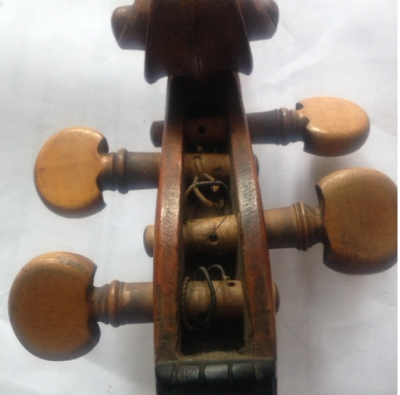

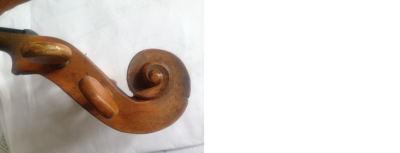

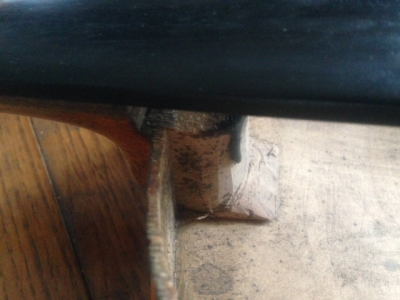

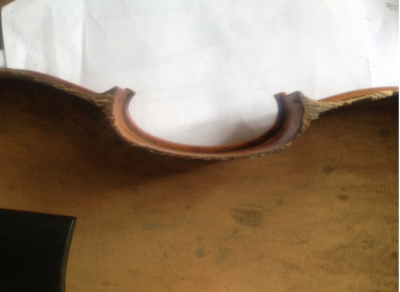

Regulars
 Offline
Offline





I suppose I was being hasty in wondering if the pegs were original. My reasoning was that modern violins tend to have such nice pegs when they are higher quality.
But boxwood was very popular early on with a lot of things, especially woodwind instruments until some time in the 19th century when industry and Romanticism and ebony took over. I have no idea about fingerboards, though - I assume they were always ebony. There was a time when neck angles of older violins, including strads, was being increased. Yours presumably postdates that process. But if all this happened in the first quarter of the 19th century, it's not evidence of anything.
Andrew
Verified human - the ignominy!
Regulars
 Offline
Offline





Member
Gordon Shumway said
Perhaps the best way to avoid accusations on maestronet is never to mention money?
In the cases I mentioned (including my own) no one did mention money.
That said, where money was only once mentioned, in one weird instance I experienced, they got very angry indeed with me for presumably hitting a raw nerve in pointing out that dealers were advertising in their online and high-street shops a German Trade violin as being French. In fact, selling such violins that can be bough on eBay for under £30 for well over £1000. This is the violin in question. In my opinion it is worth no more than about £120 (max) and £90-£100 would be a fair price. https://spinachirony.wordpress.....it-violin/
Member
Gordon Shumway said
I see with embarrassment that we are basically back to everything you say in your OP, and I have made zero net contribution.
Not at all Gordon. The exercise has been extremely educational for me. Not conclusively finding something to prove something - after much research - is much the same as finding it. The result is still a result that takes us further along the road to the facts of the matter that can probably be more firmly established in the future.
Regulars
 Offline
Offline





Elophe Poirson seems to be the only contender, and half the sources say he was a telegraph operator and highly skilled self-taught luthier (after 1870): the other half say he imported violins from Turin and did nothing but varnish them! (there's a French site that says that one of his violins can be proved never to have been opened, the varnishing being evidence, except for him to stick his label inside)
Nous avons retrouvé un violon signé Poirson qui n’avait jamais été détablé, présentant cependant de nombreuses esquilles non recollées, par lesquelles son vernis avait pénétré. Ceci prouve que Poirson a seulement ouvert l’instrument pour poser sa marque et placer son étiquette. Par ailleurs, la barre de ce violon est tout à fait caractéristique de l’Ecole de Turin à la fin du XIXème siècle.
https://www.guichetdusavoir.or.....voir/66691
https://www.viaductviolins.com.....lophe.html
If we can infer that he was a tricky operator, then probably he commissioned many violins of many different qualities from Turin and France and burnt his name on all of them.
The shape of the bassbar, I gather, can be a clue. But the picture of the table makes me wonder about the reinforcements to the main seam. I wonder how common that is - how badly must it have been glued in the first place to need it, and is that the best way to repair it?
(P.S. I half wondered if the date inside was 1896, unless it is a biographical note)
Andrew
Verified human - the ignominy!
Member
If it in fact was written to be read as 1896 then everything adds up far more easily than if it was supposed to be read as 1836. I had another look in light of your comment. It could have been meant to be 1896. 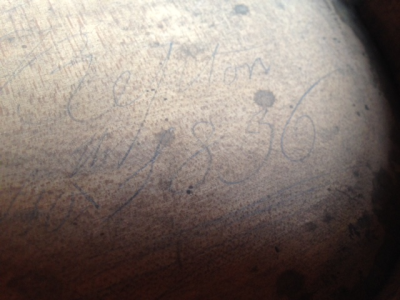

Could be 1896.
One of the cleats at the bottom is only half stuck now and the seam is open from the bottom to the next spruce cleat up (which has held). I am going to re-hide glue it and clamp it up to the cleat that is working fine and then I going to do what they did in the very old days. I am going to use a small 1/2 cm square of genuine parchment, hot hide glued in place and then gently clamped to replace the failed spruce cleat.


 Log In
Log In Register
Register







